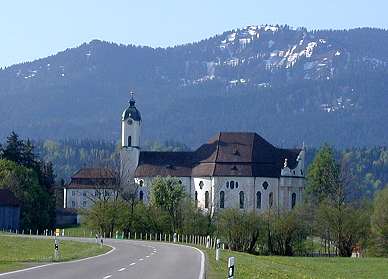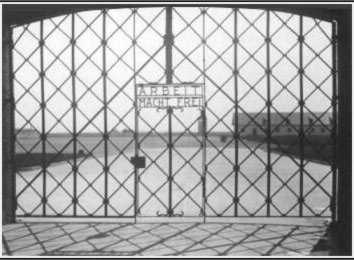
This is King Ludwig's most famous castle. With its turrets and
mock-medievalism, its interior styles ranging from Byzantine through Romanesque to Gothic
its a real fairy-tale fantasy come true. It was built between 1869 and 1886 for the
Bavarian King Ludwig II.
Only about a third of the building was actually completed. The 15 rooms you see on the
tour show astonishing craftsmanship and richness of detail.Woodcarving in Ludwig's bedroom
took 14 carpenters 4 1/2 years to complete. Wagner's operas feature everywhere in the form
of murals.
The best view of the castle and a 45m waterfall is from the nearby Mary's Bridge
(Marienbruecke), which spans a deep gorge. On the path between this bridge and the castle
is a wonderful view of Hohenschwangau and the Alpsee.

 Pilgrimage
Church of the Scourged Saviour.
First time visitors in the Wies, with no previous knowledge about the
church, may well stand in wonder and ask themselves what could have
possibly given rise to the building of such an unusually magnificent
church in such a secluded place.
Pilgrimage
Church of the Scourged Saviour.
First time visitors in the Wies, with no previous knowledge about the
church, may well stand in wonder and ask themselves what could have
possibly given rise to the building of such an unusually magnificent
church in such a secluded place.
Indeed, something out of the ordinary,
from many points of view, took place here. Human tears, an age-old
phenomenon, were the spiritual building stones, the precious pearls from
which the Wies Church, a world famous roccoco jewel, was created. In the
18th Century the Wies Church was already known throughout Europe as a
place of reverence for the Scourged Saviour, and at the same time a famous
gem
of baroque architecture.
Even today the church lives from both these
wellsprings: its spiritual and artistic richness. Thus, the Wies Church
continues as a pilgrimage church, a place of prayer and worship, and is
simultaneously a magical drawing point for millions of visitors. Through their
encounter with this joyous Baroque, full of life and hope, they sense a world
which moved the writer Peter Dörfler, in the first half of this century, to
write: "The Wies is a bit of heaven in this suffering world."


"Dachau - the significance of
this name will never be erased from German history. It stands for all concentration camps
which the Nazis established in their territory."
(Eugen Kogon)

